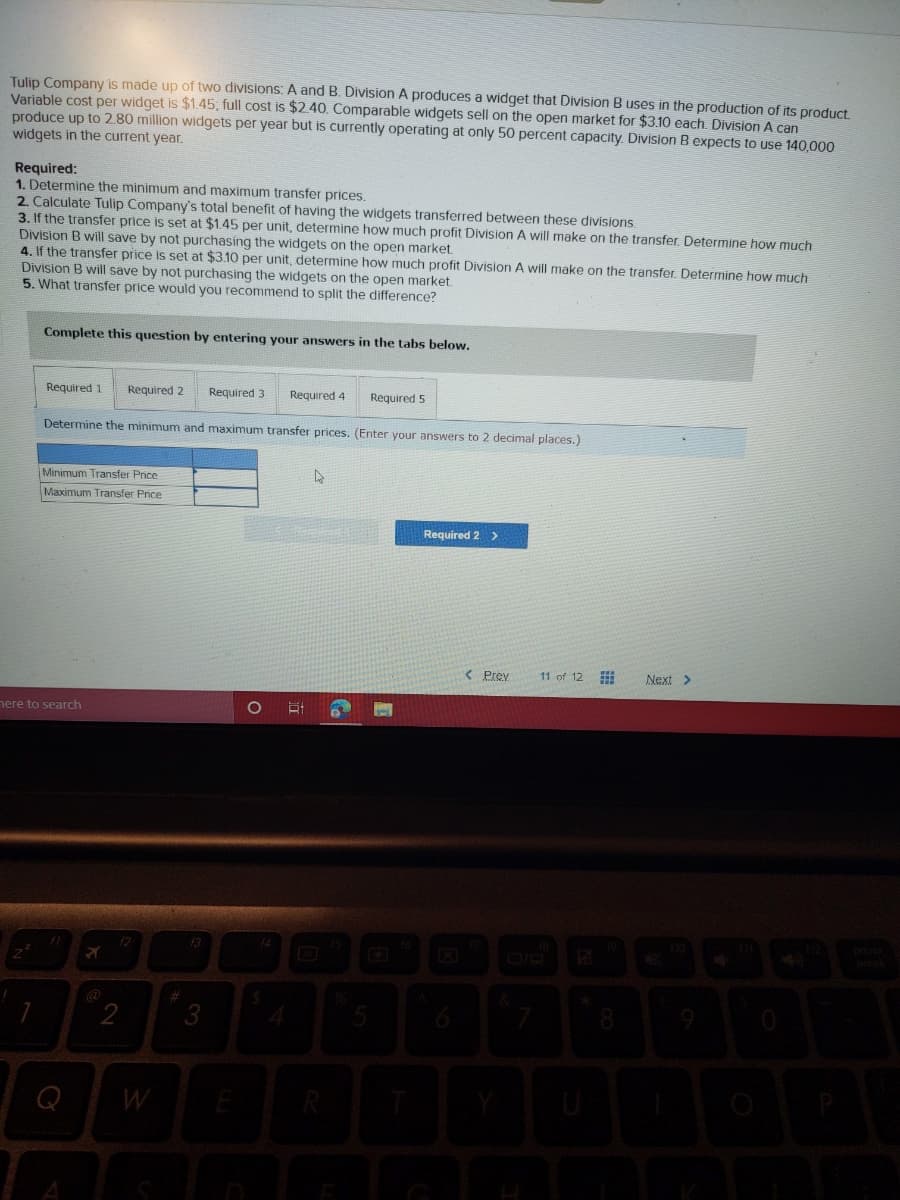Tulip Company is made up of two divisions: A and B. Division A produces a widget that Division B uses in the production of its product. Variable cost per widget is $1.45, full cost is $2 40. Comparable widgets sell on the open market for $3.10 each. Division A can produce up to 2.80 million widgets per year but is currently operating at only 50 percent capacity. Division B expects to use 140,000 widgets in the current year. Required: 1. Determine the minimum and maximum transfer prices. 2. Calculate Tulip Company's total benefit of having the widgets transferred between these divisions 3. If the transfer price is set at $1.45 per unit, determine how much profit Division A will make on the transfer. Determine how much Division B will save by not purchasing the widgets on the open market A If the
Tulip Company is made up of two divisions: A and B. Division A produces a widget that Division B uses in the production of its product. Variable cost per widget is $1.45, full cost is $2 40. Comparable widgets sell on the open market for $3.10 each. Division A can produce up to 2.80 million widgets per year but is currently operating at only 50 percent capacity. Division B expects to use 140,000 widgets in the current year. Required: 1. Determine the minimum and maximum transfer prices. 2. Calculate Tulip Company's total benefit of having the widgets transferred between these divisions 3. If the transfer price is set at $1.45 per unit, determine how much profit Division A will make on the transfer. Determine how much Division B will save by not purchasing the widgets on the open market A If the
Cornerstones of Cost Management (Cornerstones Series)
4th Edition
ISBN:9781305970663
Author:Don R. Hansen, Maryanne M. Mowen
Publisher:Don R. Hansen, Maryanne M. Mowen
Chapter10: Decentralization: Responsibility Accounting, Performance Evaluation, And Transfer Pricing
Section: Chapter Questions
Problem 4CE
Related questions
Question
Answer all five of the required questions!

Transcribed Image Text:Tulip Company is made up of two divisions: A and B. Division A produces a widget that Division B uses in the production of its product.
Variable cost per widget is $1.45, full cost is $2.40. Comparable widgets sell on the open market for $3.10 each. Division A can
produce up to 2.80 million widgets per year but is currently operating at only 50 percent capacity. Division B expects to use 140,000
widgets in the current year.
Required:
1. Determine the minimum and maximum transfer prices.
2. Calculate Tulip Company's total benefit of having the widgets transferred between these divisions.
3. If the transfer price is set at $1.45 per unit, determine how much profit Division A will make on the transfer. Determine how much
Division B will save by not purchasing the widgets on the open market.
4. If the transfer price is set at $3.10 per unit, determine how much profit Division A will make on the transfer. Determine how much
Division B will save by not purchasing the widgets on the open market.
5. What transfer price would you recommend to split the difference?
Complete this question by entering your answers in the tabs below.
Required 1
Required 2
Required 3
Required 4
Required 5
Determine the minimum and maximum transfer prices. (Enter your answers to 2 decimal places.)
Minimum Transfer Price
Maximum Transfer Price
Required 2 >
< Prev
11 of 12
Next >
nere to search
f3
W
Expert Solution
This question has been solved!
Explore an expertly crafted, step-by-step solution for a thorough understanding of key concepts.
This is a popular solution!
Trending now
This is a popular solution!
Step by step
Solved in 4 steps with 1 images

Knowledge Booster
Learn more about
Need a deep-dive on the concept behind this application? Look no further. Learn more about this topic, accounting and related others by exploring similar questions and additional content below.Recommended textbooks for you

Cornerstones of Cost Management (Cornerstones Ser…
Accounting
ISBN:
9781305970663
Author:
Don R. Hansen, Maryanne M. Mowen
Publisher:
Cengage Learning

Managerial Accounting
Accounting
ISBN:
9781337912020
Author:
Carl Warren, Ph.d. Cma William B. Tayler
Publisher:
South-Western College Pub

Principles of Accounting Volume 2
Accounting
ISBN:
9781947172609
Author:
OpenStax
Publisher:
OpenStax College

Cornerstones of Cost Management (Cornerstones Ser…
Accounting
ISBN:
9781305970663
Author:
Don R. Hansen, Maryanne M. Mowen
Publisher:
Cengage Learning

Managerial Accounting
Accounting
ISBN:
9781337912020
Author:
Carl Warren, Ph.d. Cma William B. Tayler
Publisher:
South-Western College Pub

Principles of Accounting Volume 2
Accounting
ISBN:
9781947172609
Author:
OpenStax
Publisher:
OpenStax College

Financial And Managerial Accounting
Accounting
ISBN:
9781337902663
Author:
WARREN, Carl S.
Publisher:
Cengage Learning,

Managerial Accounting: The Cornerstone of Busines…
Accounting
ISBN:
9781337115773
Author:
Maryanne M. Mowen, Don R. Hansen, Dan L. Heitger
Publisher:
Cengage Learning

Principles of Cost Accounting
Accounting
ISBN:
9781305087408
Author:
Edward J. Vanderbeck, Maria R. Mitchell
Publisher:
Cengage Learning